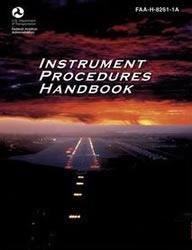INSTRUMENT PROCEDURES HANDBOOK

The Instrument Procedures Handbook may be considered as Part 2 of a complete instrument flying ground school curricullum, (along with Instrument Flying Handbook 8083-15A) expanding on it to the actual in-cockpit operational procedures.
The Procedures Handbook provides detailed coverage of instrument charts and procedures including IFR takeoff, departure, enroute, approach and landing. Safety information covering subjects such as runway incursion, land and hold short operations, CFIT, and human factors are covered. The text emphasizes airplane operations but also includes guidelines for helicopter instrument procedures.
Also included are guidelines and insights into the rapidly evolving IFR environment including new technologies such as: Global Positioning System (GPS), Local and Wide Area Augmentation System (LAAS & WAAS), Reduced Vertical Separation Minimums (RVSM) and more.
Table of Contents
- IFR Operations in the National Airspace System: system safety, system capacity, managing safety and capacity, avionics and instrumentation, disseminating aeronautical information
- Takeoffs and Departures: safety in the departure environment, takeoff minimums
- IFR alternate minimums: departure procedures
- Enroute Operations: enroute navigation
- IFR enroute altitudes: reporting procedures, communication failure, climbing and descending enroute, holding procedures, fuel state awareness, diversion procedures, enroute RNAV procedures
- Arrivals: transition from enroute, high performance arrivals, sterile cockpit concept, standard terminal arrival routes
- Approaches: approach planning, types of approaches
- System Improvement Plans: fleet improvement, increasing capacity and safety, reducing enroute congestion, developing technology
- Appendixes: airborne navigation databases, approach chart format changes, helicopter IFR operations, acronyms and glossary

Отзывы ещё не добавлены